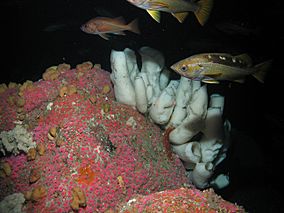Greater Farallones National Marine Sanctuary facts for kids
Quick facts for kids Greater Farallones National Marine Sanctuary |
|
|---|---|

Yellowtail rockfish over boot sponges in Greater Farallones NMS
|
|

Map of the Greater Farallones sanctuary
|
|
| Location | Gulf of the Farallones, California, United States |
| Area | 3,295 sq mi (8,530 km2) |
| Established | 1981 |
| Governing body | NOAA National Ocean Service |
The Greater Farallones National Marine Sanctuary is a special ocean area off the coast of California. It protects amazing wildlife, their homes, and important historical sites. This sanctuary covers a huge area of 3,295 square miles (that's over 8,500 square kilometers!) and is one of the richest ocean environments in the world. Many different kinds of plants and animals live here, including some that are rare or in danger.
Contents
About the Sanctuary
Why We Protect Our Oceans
Back in 1972, people started to realize how important our coastal waters are. So, the United States Congress passed a law called the National Marine Sanctuaries Act. This law allowed the government to create special ocean areas called National Marine Sanctuaries. These sanctuaries help protect important waters and provide safe homes for ocean animals. They also keep historical shipwrecks safe and are great places for research, fishing, watching wildlife, boating, and tourism.
History and Growth
The Greater Farallones National Marine Sanctuary was first created in 1981. It was originally called the Gulf of the Farallones National Marine Sanctuary. At that time, it covered about 1,279 square miles near San Francisco Bay. It protected open ocean, shallow tidal areas, rocky shores, wetlands, underwater reefs, and beaches.
In 2015, the sanctuary grew much larger! It expanded to cover 3,295 square miles and changed its name to Greater Farallones National Marine Sanctuary. This expansion helped protect even more of the ocean. The sanctuary also helps manage a part of the nearby Monterey Bay National Marine Sanctuary. You can find the main office and a visitor center for the Greater Farallones Sanctuary in San Francisco.
A Special Ocean Ecosystem
The Greater Farallones Sanctuary is part of a huge ocean system called the California Current ecosystem. This system stretches along the western coast of North America. It's one of the most productive ocean areas on Earth! This is because of something called "wind-driven upwelling." This process brings lots of nutrients from the deep ocean up to the surface. These nutrients act like fertilizer for tiny ocean plants, which then feed many other animals.
Amazing Wildlife
This sanctuary is incredibly diverse and full of life. It's a vital place for many animals to breed and find food. You can find at least twenty-five species here that are either endangered or threatened.
- Marine Mammals: Over thirty-six types of marine mammals live here. This includes giant blue, gray, and humpback whales. You might also spot harbor seals, elephant seals, and Pacific white-sided dolphins. It's also home to one of the southernmost groups of threatened Steller sea lions in the U.S.
- Seabirds: More than a quarter-million seabirds come here to breed.
- Sharks: The sanctuary is home to one of the most important populations of white sharks on the planet.
Neighboring Sanctuaries
The Greater Farallones National Marine Sanctuary is connected to two other National Marine Sanctuaries: the Monterey Bay National Marine Sanctuary and the Cordell Bank National Marine Sanctuary. Together, these sanctuaries protect a huge area of the Pacific Ocean. This area is also part of the United Nations' Golden Gate Biosphere Reserve. Inside the sanctuary, you'll find the Farallon Islands and their special National Wildlife Refuge.

